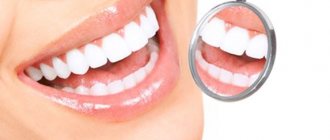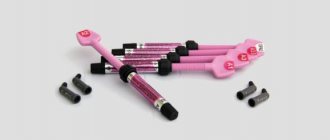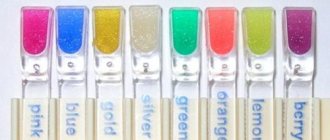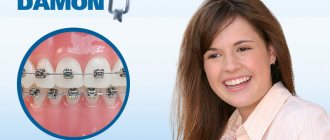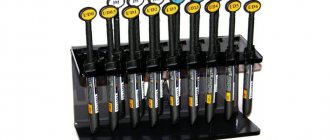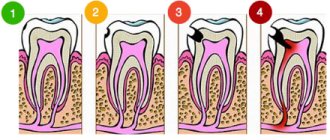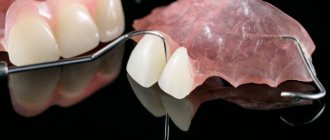Many dental clinics offer fillings using several different filling materials. Price lists (including those posted on websites) are also often replete with various commercial names of fillings: Filtek, Spectrum, Aesthetics, Charisma (Karizma), Vines (Venus), Gradia, Estelite, Herculite, Point, Tetrik, Admira, Brilliant, Enamel Plus and others. Patients are asked to make a choice, but this requires dental-level knowledge, which most people, of course, do not possess.
Popular articles on the Internet for the following queries: “which filling is better?”, “which filling material is the best?”, “which filling is better to put?” and so on. – do little to clarify the situation. Most articles (often written by anonymous authors or copywriters) discuss only classes of filling materials: cements, amalgams, glass ionomers, chemical and light-curing composites. After a detailed description of materials that went out of use several decades ago (apparently to give more volume to the text), the conclusion is made that light-curing composites are the best, and if a person has the financial means, then it is advisable to install fillings from them. Either nothing is mentioned about specific brands of heliocomposites, or it is stated that they are all approximately equally good. Or “the latest generation nanocomposites” begin to be advertised.
What fillings do not need to be placed?
The first and most important thing that every patient should understand is that light-curing fillings (photopolymers, heliocomposites) are the only reasonable choice in the 21st century. Even for people on a budget. Other materials are not 10 or 20 percent, but many times worse. Discussing the advantages or price/quality ratio of cement fillings in our time is as stupid as looking for advantages, for example, in reel-to-reel tape recorders. For a long time now, no one has been producing or buying cassette and video recorders, but for some reason some individuals allow themselves to install a 19th-century seal.
Plastic fillings are completely beyond reason. Acrylic oxide and similar anachronisms should have been banned for use a quarter of a century ago, since they are not only unable to stop the further spread of caries, but also provoke its progression. A plastic filling on a tooth is a direct road to pulpitis and periodontitis. You have to hate yourself with a fierce hatred to allow this to happen to you. And clinics that currently use such materials will be deprived of their license.
Amalgam fillings are famous for their durability, but due to toxicity (not for the patient, but for the environment and medical staff), dentists themselves refuse them.
Chemical composites are moderately bad - if a person lives from hand to mouth, then, of course, you can install them (it’s still better than nothing). But for most other people who do not experience urgent need every day, this will not be a justifiable choice. It may happen that such a filling will last for many years, but more often the opposite happens. After 3-5 years (or earlier), caries will develop under the “chemical” filling, and it can either reach pulpitis, or the amount of destruction will become so great that instead of re-installing the filling, the manufacture of an inlay or onlay will be required. As a result, the cost of repeated intervention increases by an order of magnitude due to the savings of thousands of rubles the first time (the approximate difference with the cost of a light-curing composite).
Acrodent - dental material (powder 3 colors, 20 g, liquid - 50 g) from the company Inversion
- - Buy
- Buy in 1 click The application has been sent, we are checking the phone number.
Delivery by courier - from 300 rubles Just a little more!
There are 3,000 rubles left until free delivery in Moscow. Pickup is free. Payment is non-cash/cash. We work as with a legal entity. individuals as well as individuals. persons. Wholesale prices - from an order amount of more than 30,000 rubles The product is certified - at your request we will prepare a registration certificate, certificates, declarations for the product Own warehouse and showroom
Analogues of Acrodent
Similar materials are plastics for crowns Villacryl S in powder (100 g) and liquid (200 ml). Their price ranges from 500 to 830 rubles.
Also A crodent analogues are: Acrylic oxide, Acrodent
Select city
The “Market” section is an electronic catalogue. All information in this section is for reference only and is not a public offer.
All materials presented on the site are for informational and reference purposes only. Consult your doctor.
The “Market” section is an electronic catalogue. All information in this section is for reference only and is not a public offer.
All materials presented on the site are for informational and reference purposes only. Consult your doctor.
Where can I buy?
There are currently no prices for this product.
Acrodent Plastic for orthopedic dentistry
Instructions for use
To prepare the mixture you need:
- In a 2:1 ratio of powder and water.
- Stir for about a minute.
- The mass is plastic up to 120 seconds.
- The mixture hardens in about 10 minutes.
- Polish without load.
- The colors are uniform, dental.
We invite you to familiarize yourself with Herpes medicine for children and adults
If you follow the instructions, working with the material is not very difficult.
Equipment
- Powder: color A2, A3, B2 20 g each (3 bottles)
- Liquid 50 g (2 bottles of 25 g each)
- Powder measuring cup 1 pc.
- Dropper plug 2 pcs.
- Instructions for use
Purpose
- Manufacturing of temporary plastic crowns;
- Relining any plastic crowns;
- Restoration of the chewing surface of artificial plastic teeth in removable laminar dentures and devices when they are worn out;
- Restoration of bite height;
Side effect
Much of the negative impact can be caused by the design of the prostheses. It is impossible to completely eliminate these uncomfortable sensations. Even changing to another prosthesis will not give the desired result.
There may even be side effects such as allergies. Moreover, the symptoms are completely different. For example, this could be a reaction such as rashes or even wounds, especially in places where the denture comes into contact with the gums. Manifestations of the reaction can be observed from several minutes to several hours.
Material such as Sinma-M is used not only as an independent material, but also as an additional ingredient. When it is combined with Acrodent, the manufacturing process is accelerated and the negative impact on the gums is reduced.
I read the information on the Internet and thought for a long time about where I could buy this alloy. Then I tried typing “Acrodent” and my city into a search engine. Since I live in a small town, I didn’t see any answer.
Then I typed in my area and that’s the only way I found what I needed. There are various websites that sell this drug online. I have been using these designs for 2 years. Now the product needs correction.
This process takes several hours.
Alyona
I had to use acrylic dentures very early. Heredity, childbirth, and harmful work had a negative impact on my health. I like Acrodent, but there is one caveat.
As soon as I started using dentures, I started using gel at the same time. It provides an analgesic effect.
In fact, it needs to be applied after the structure has already been demolished normally.
We suggest you familiarize yourself with Swelling in the throat, I can’t swallow, it’s difficult to breathe
Svetlana
And it was very difficult for me to use the prosthesis. I start gagging very quickly. The doctor recommended special pills, and also to take out the prosthesis when nausea starts to set in.
Olga
I also use acrylic dentures. I had problems eating food. For the first time in days, I only ate puree and even crushed buckwheat using a blender.
Advantages
- Does not have a “sand stage”;
- High plasticity;
- Crowns are easy to process and polish;
- Can be applied layer by layer, with high adhesion between layers;
Registration
You cannot write a personal message to this person because you are not a member of the Dental Club.
Effectiveness, indications
Acrylic plastic has been used in orthopedic dentistry for 4 years. Not only individual teeth are made from it, but also an entire row of teeth.
Indications for use:
- to restore chewing functions;
- for reformatting other crowns;
- for the manufacture and use of temporary prostheses.
The pharmacy sells a set of powders in 3 colors. Each of them weighs 20 grams. Additionally, there is a special liquid in the size of two bottles of 25 grams. The set also includes 2 dropper plugs, instructions for use and a powder measuring stick. The liquid is used to create dental crowns.
Acrodent can be used not only as the main material, but also as an additional one. Thus, it is used:
- when creating occlusal pads in medical devices;
- to correct the shape, size or color of fixed teeth;
- for processing artificial teeth that are removable.
The advantage of using this material is that it bonds well. It does not have a “sand stage” and is easy to mold. It has a high resistance to abrasion, as well as deformation during pressure. Since the alloy can be easily and simply cared for and polished, the shine of teeth is maintained for a long time.
We invite you to familiarize yourself with Diplen Denta M (with metronidazole)
How much does acrodent cost?
The price of the drug on different sites differs slightly. On average it ranges from 873 to 950 rubles.
Source: https://imdent.ru/akrodent-instruktsiya-analogi-tsena/
Light-curing fillings are not uniform
Glass ionomer cements with a light-initiated curing mechanism are available. For example, Fuji 2 (Fuji II LC). Compomers (a hybrid material between composites and glass ionomers) are also cured using a lamp. Their most famous representative is Dyract XP. These materials are more reliable than some heliocomposites, but are still significantly inferior to their best representatives. Due to the misconception about the toxicity of composites, some doctors recommend these materials for filling for children. For pediatric dentistry, Fuji and Direct are acceptable options, but composites are still preferable.
Dental composite materials are divided into universal (suitable for filling any cavities), aesthetic for anterior teeth (excellently convey all the nuances of the color of natural teeth) and packable for chewing teeth (have low shrinkage and abrasion, but also low aesthetic characteristics). There is another class of composites – flowable. Previously, they were recommended for filling wedge-shaped defects due to their high elasticity, however, according to modern data, universal composites give better results even with non-carious lesions.1 Therefore, current composites currently have only an auxiliary value: they are used together with other classes of materials, but the main one the volume of the filling does not make up.
Universal heliocomposites are the most widely used type of filling materials in the world. The commercial names of fillings offered to the patient to choose from mostly refer to these materials. They also differ in quality. The percentage of inorganic filler, its chemical composition and the shape of the granules determine the mechanical properties of the filling: polymerization shrinkage, mechanical strength, hardness and wear resistance, polishability and surface smoothness. Some of these parameters antagonize each other. For example, for good polishability, the granules of non-limiting filler (oxides of silicon, zirconium, aluminum, etc.) should be as small as possible, and to increase strength, on the contrary, as large as possible. Therefore, materials advertised as “nanocomposites” cause a wry smile among professionals - the prefix “nano-” attracts illiterate dentists and patients who blindly associate it with high technology. However, for the sake of fairness, quite good material can be presented. For example, Filtek Ultimate.
Acrodent: instructions, price, where to buy, side effects
Treatment of patients with problems of teeth, oral mucosa and gums is a major challenge in dentistry in the 21st century. A new feature was the use of temporary prostheses. They are mainly made of acrylic plastic.
But after research, it became known that they can lead to worsening diseases, because most plastics come into contact with saliva and the oral cavity throughout the day.
However, there is an excellent replacement - Acrodent material.
Instructions for use
You need to take 2 parts of the powder and dilute with water. Stir well for 1 minute. It must be remembered that the mass that was made retains its elasticity for two minutes. Complete hardening occurs after 10 minutes. Next comes polishing.
You can buy Acrodent in an online store or in a pharmacy. Its approximate price is 375 hryvnia or 900 rubles.
The best filling materials (as of 2022)
In the dental world, the greatest authority in the assessment of restorative materials currently belongs to the American publication The Dental Advisor. For the last 12 years (from 2010 to 2022), the highest award in the “universal composites” category has been awarded to the Japanese filling material Estelite Sigma Quick. Selection criteria: percentage of inorganic filler, amount of shrinkage, correspondence of shades to the natural color of the tooth, ease of use, radiopacity, polishability. A survey of dentists showed that they switch to Estelite more often than to other filling materials. Clinical success of Estelite is 99%.2
Among aesthetic composites in 2015, 2016, 2022, according to the same publication, the filling material from Germany, Venus Pearl, took the highest position. Its clinical effectiveness is 91%.3 In 2021, it received the title of “preferred product”. It can also be used for chewing teeth.
In 2022 and 2022, first place in the category of aesthetic composites was taken by the Harmonize material of the American manufacturer Kerr Restorative.4
Other good quality filling materials should also be mentioned. These include those who received awards in 2016-2019: Omnichroma, Brilliant EverGlow, Admira Fusion, Filtek Supreme Plus and Filtek Supreme Ultra.
Rating of filling materials:
| Filling material | Manufacturer | Rated by The Dental Advisor | Year of last assessment |
| Estelite Sigma Quick | Tokuyama Dental (Japan) | 99% | 2021 |
| Herculite Ultra | Kerr (USA) | 98% | 2016 |
| Tetric EvoCeram | Ivoclar Vivadent (Liechtenstein) | 97% | 2017 |
| Harmonize | Kerr (USA) | 96% | 2019 |
| Filtek Supreme Universal Restorative | 3M (USA) | 96% | 2019 |
| Filtek Supreme Plus | 3M (USA) | 96% | 2018 |
| Filtek Supreme Ultra | 3M (USA) | 96% | 2018 |
| Brilliant EverGlow | Coltene (Switzerland) | 96% | 2018 |
| Beautiful II LS | Shofu (Japan) | 96% | 2018 |
| Grandio SO | VOCO (Germany) | 96% | 2012 |
| Gradia | GC (Japan) | 96% | 2007 |
| Omnichroma | Tokuyama Dental (Japan) | 94% | 2020 |
| Beautiful II | Shofu (Japan) | 94% | 2009 |
| Admira Fusion | VOCO (Germany) | 93% | 2019 |
| Venus Pearl | Kulzer (Germany) | 91% | 2021 |
| Premise | Kerr (USA) | 91% | 2005 |
